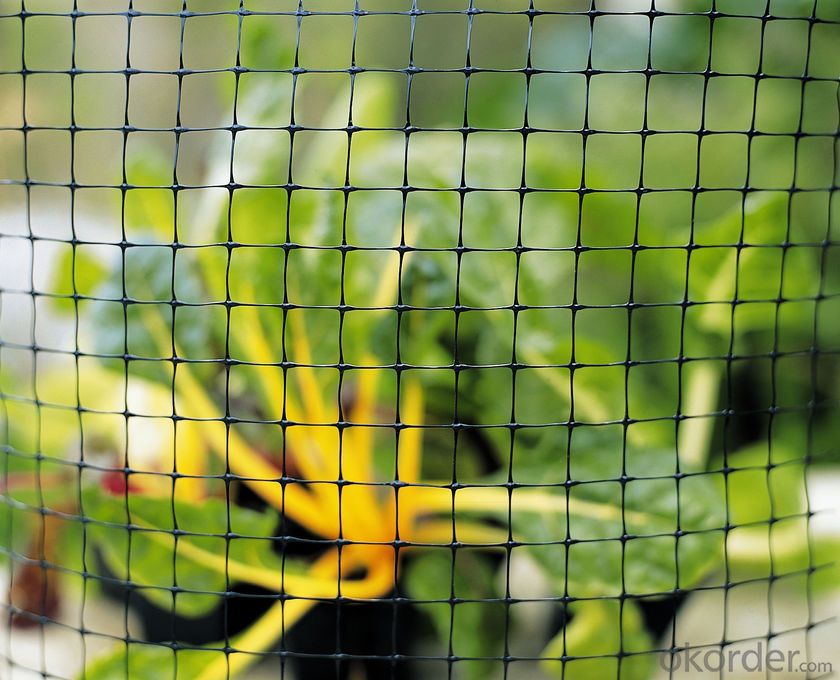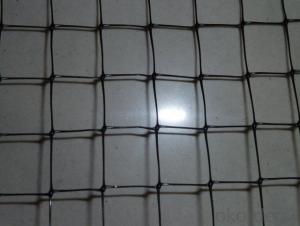Deer Guard Fence, Extruded PP Deer Guard Netting
- Loading Port:
- China main port
- Payment Terms:
- TT OR LC
- Min Order Qty:
- 5000 m²
- Supply Capability:
- 1000000 m²/month
OKorder Service Pledge
OKorder Financial Service
You Might Also Like
Plastic netting plastic mesh breeding mesh
1. Plastic Plain Netting
Colour:white,black,blue and green, client's requirement.

2. Deer fence introduction:
Deer fencing is a very high strength, lightweight, 3.6ft to 7.3ft high deer fence manufactured from high strength polypropylene BOP plastic netting. Deer have a tendency to forage over large areas and the cost effective deer fencing offers a very effective deer control barrier.
The deer fence is black, UV stabilised and rot proof and unobtrusive as it merges into it's background. Deer fencing is very quick and easy to erect and each roll weighs less than 15kg. The Deer Netting should be installed by battening to the fencing posts to ensure the mesh filaments are not damaged.
3. Features of the deer neeting fence:
Deer fence is easy to erect and install
Plastic netting has a mesh hole size of 0.06" ,0.08",0.18",0.19"
The BOP plastic netting has a high tensile strength
Plastic mesh is UV stabilized and chemical resistant
Deer fencing rolls are lightweight
Deer fencing is a very high strength, lightweight 1.8m high Deer fence manufactured from polypropylene.
Deer fencing net is supplied on a 100m long roll
4. Features:
1). Low cost, while has superior strength
2). Has anti-tearing and friction capability
3). Wide range of product availability, some other mesh sizes and weights can also produced as per customers' requirements.
5. Package/Payment/Delivery:
Package: Usually packed by rolls in plastic film bags with labels inside and then loosely loaded in the container
6. FAQ:
Q1: What is your minimum order quantity?
A:The minimum order quantity is 5000 ,but it is negotiable.
Q2:What is your payment terms?
A: T/T,Western Union,Paypal,L/C...
Q3:What is your delivery time?
A:Production time usually costs 2-20 days.
Waiting to cooperate with you!
- Q:Geotextile and non-woven fabrics What is the difference
- Geotextile is divided into two non-woven geotextile and woven geotextile, non-woven geotextile and acupuncture and spunlace, staple fiber and long fiber. Nonwovens means that the manufacturing process does not require weaving. Geotextiles are used for geotechnical engineering. Geotextile is part of the textile does not require the manufacture can be made, called non-woven geotextile. Non-woven fabrics can be used very broad, like we use the heart of the soft wipes, are non-woven, as well as the hotel put the shoes of the shoes, but also non-woven.
- Q:Are geotextiles suitable for use in drainage ditches?
- Yes, geotextiles are suitable for use in drainage ditches. Geotextiles can be used as a filtration and separation layer in drainage systems to prevent soil erosion and clogging while allowing water to flow through. They help improve the overall performance and longevity of drainage ditches by enhancing their filtration and drainage capabilities.
- Q:How do geotextiles help with stabilization of railway tracks?
- Geotextiles help with the stabilization of railway tracks by providing reinforcement and separation. They act as a barrier, preventing the mixing of different soil layers and improving load distribution. Additionally, geotextiles enhance drainage and filtration, reducing the risk of water accumulation and associated track instability.
- Q:Geotextile what role
- Geotextile is a new type of building materials, raw materials are polyester, acrylic, nylon and other polymer polymer synthetic fiber.According to the manufacturing method is divided into: there are two types of textile and non-woven geotextile geotextile with anti- Filter, drainage, isolation, reinforcement, protection, sealing and other functions, it is compared with conventional masonry and concrete anti-seepage effect, with low investment, simple construction process, short duration, good anti-seepage effect, effective channels The use of high coefficient of the advantages of water conservancy project dam and slope protection, channel isolation, seepage; road, railway, airport runway foundation isolation, filter, drainage, slope, retaining wall and road reinforcement, drainage; Construction of the soft foundation treatment, beach embankment, harbor wharf and breakwater reinforcement, drainage; landfill, thermal power plant ash dam, concentrator tailing dam isolation, seepage; geotextile has been widely used in infrastructure construction , And gradually applied to a wider range of areas.
- Q:Can geotextiles be used for drainage purposes?
- Yes, geotextiles can be used for drainage purposes. They are commonly used to improve soil drainage by allowing water to pass through while preventing soil erosion and clogging.
- Q:What are the factors that affect the effectiveness of geotextiles in erosion control?
- Some factors that affect the effectiveness of geotextiles in erosion control include the type and quality of the geotextile material, the installation method, the slope gradient and soil type, the amount and intensity of rainfall, and the presence of vegetation or vegetation establishment.
- Q:River slope protection geotextile unit area quality is generally how much
- Under normal circumstances is 100g - 1000g / square meter of the specifications, the actual situation is subject to special requirements, usually available geotextile unit area quality tester for testing, reference [standard group]. Test criteria: ASTM / D3776 / 2646, ISO3801, BS3424 / 2471, BSEN, M + SP65 / 65A, NEXT20
- Q:Garden engineering. Do the roof of the hydrophobic board and geotextile roof, would like to know the hydrophobic board and geotextile "sub-project name" and "hidden project"
- I made these two materials wish smooth
- Q:What are the specifications for geotextiles used in erosion control mats?
- The specifications for geotextiles used in erosion control mats typically include factors such as material composition, weight, thickness, tensile strength, permeability, and UV resistance. These specifications are important to ensure the geotextiles effectively prevent soil erosion, withstand environmental conditions, and provide long-term durability.
- Q:Can geotextiles be used for reinforcement of slope toe protection systems?
- Yes, geotextiles can be used for reinforcement of slope toe protection systems. Geotextiles are often utilized in slope stabilization projects to provide reinforcement and prevent erosion at the base of slopes. They can effectively enhance the stability of slope toe protection systems by distributing loads, improving drainage, and reducing the risk of soil erosion.
1. Manufacturer Overview |
|
|---|---|
| Location | |
| Year Established | |
| Annual Output Value | |
| Main Markets | |
| Company Certifications | |
2. Manufacturer Certificates |
|
|---|---|
| a) Certification Name | |
| Range | |
| Reference | |
| Validity Period | |
3. Manufacturer Capability |
|
|---|---|
| a)Trade Capacity | |
| Nearest Port | |
| Export Percentage | |
| No.of Employees in Trade Department | |
| Language Spoken: | |
| b)Factory Information | |
| Factory Size: | |
| No. of Production Lines | |
| Contract Manufacturing | |
| Product Price Range | |
Send your message to us
Deer Guard Fence, Extruded PP Deer Guard Netting
- Loading Port:
- China main port
- Payment Terms:
- TT OR LC
- Min Order Qty:
- 5000 m²
- Supply Capability:
- 1000000 m²/month
OKorder Service Pledge
OKorder Financial Service
Similar products
New products
Hot products
Related keywords

































